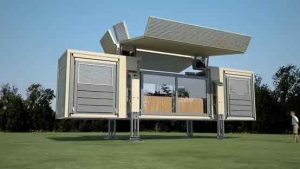Modular construction of prefabricated houses, as an emerging force in contemporary construction, is gradually changing our perception of traditional construction methods. This type of construction method realizes an efficient, flexible, economical and sustainable building process through pre-fabricated modular components in factories that are assembled on site. In this paper, we will discuss the modular construction of prefabricated houses from the aspects of definition, characteristics, advantages and practical cases of modular construction.

Definition of modular construction
Modular construction is an assembling technology, which uses pre-fabricated modular components, such as walls, floor slabs, roofs, etc., to quickly assemble various houses on site through standardized connections. This construction method not only simplifies the construction process, but also improves the overall performance and quality of the building.
Fast construction speed and high efficiency
One of the biggest features of modular construction is fast construction speed. Since most of the components are prefabricated in the factory, the site only needs to be assembled, greatly reducing the construction cycle. This not only reduces the impact on the surrounding environment during construction, but also allows the house to be ready for use much faster. For example, in some projects, the entire modular home was assembled in just one day, fully demonstrating the efficiency of the prefabricated structure construction process.
Good seismic performance and integrity
Modular constructions typically have high seismic performance. This is due to the fact that the modular components are precisely machined in the factory and their connections and overall structure are rigorously designed and tested. Building modular composite walls have stronger seismic and impact resistance compared to ordinary brick and concrete buildings due to the concrete shear wall panels, enabling the construction of houses in areas with high seismic intensity and a long service life.
Flexible design and high customizability
These buildings offer a high degree of design flexibility. They can be customized to meet specific customer needs and preferences, with an abundance of options ranging from floor plans and finishes to fixtures. In addition, modular units can be flexibly adapted to suit different terrains and environments based on site conditions. This high degree of customizability enables modular buildings to meet diverse market needs.
Energy saving and environmental protection for sustainable development
these buildings also excel in energy conservation and environmental protection. They often incorporate energy-efficient features and materials, such as improved insulation, energy-efficient windows, and energy-efficient appliances, to reduce energy consumption and operating costs. In addition, since most of the components are prefabricated in the factory, waste and pollution emissions from on-site construction are reduced, which contributes to sustainable development.
Economical and cost-effective
Prefabricated and modular homes are often more cost-effective than traditional site-built homes. Controlled factory environments allow for efficient use of materials and reduced waste, while bulk purchasing of raw materials and building factories in areas with low labor costs also reduce costs. In addition, shorter construction cycles reduce capital consumption and interest payments, making prefabricated homes more economically attractive.
Improved construction quality and efficiency
The factory production environment makes the processing precision of prefabricated components higher and the quality more stable. At the same time, the standardized production process and construction specifications also help to improve construction efficiency and quality. In addition, the assembly process of prefabricated components is simple and quick, reducing the complexity and uncertainty of on-site construction.
Reducing Construction Risks
On-site construction is affected by various factors such as weather and environment, while prefabricated components are prefabricated in the factory, reducing construction delays and risks caused by uncontrollable factors such as bad weather. At the same time, as most of the construction work is completed in the factory, it also reduces the probability of on-site safety accidents.
Promoting the development of construction industrialization
Modular construction is one of the important means to promote the development of construction industrialization. Through the factory production of prefabricated components and on-site assembly, it realizes the standardization, scale and intensification of the construction production process. This helps to improve the overall level and competitiveness of the construction industry and promote the sustainable development of the construction industry.
Know more:https://baijiahao.baidu.com/s?id=1798558091116078059&wfr=spider&for=pc
Post time: 07-31-2024







